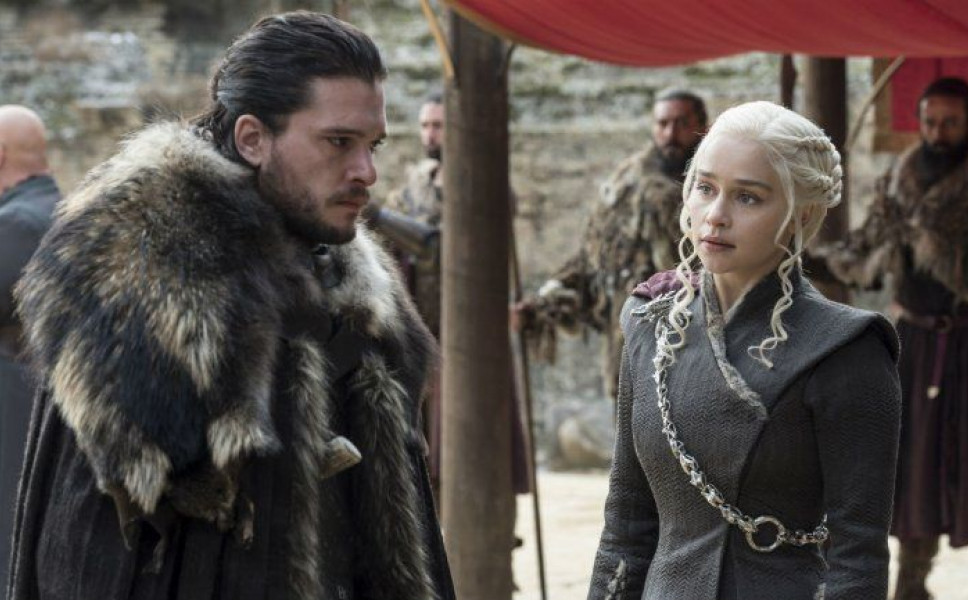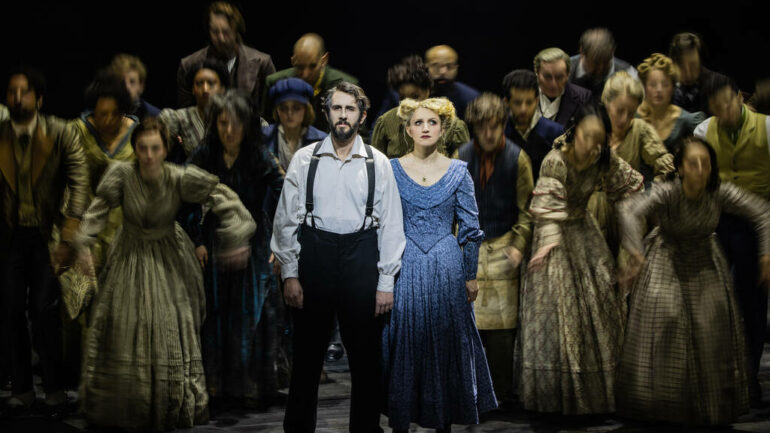chevron_left
-
play_arrow
NGradio So good... like you
A brief history of the Dragonpit

via Giphy
Just when you thought you’d seen most of King’s Landing, we finally visited one of its grandest locations — the Dragonpit. It’s a rather significant place to hold the parley, given its history. It is where dragons were both housed and slaughtered, facts which might make it appeal to both sides in the current conflict. “It must have been the most dangerous place in the world,” Tyrion marvels as they approach the arena. “This place was the beginning of the end” of the Targaryens, notes Dany.
Before the Sept of Baelor, the main Sept in King’s Landing was the Sept of Remembrance — but like the Sept of Baelor, it was destroyed by fire. (In that case, dragonfire). Maegor the Cruel blasted it as his way of disbanding the Faith Militant, just as Cersei later exploded the Sept of Baelor to reverse her restoration of the order. In place of the Sept, Maegor ordered a Dragonpit be built as a stable for the royal mounts, with forty vaults beneath a great dome. Inside the coliseum dome were benches that could seat 80,000 people, so it could also be used for public events, such as royal coronations and funerals.
As big as the pit was, it was still a confined space, and it seemed to slow the growth of the dragons bred and raised inside. None of the Dragonpit dragons — like Caraxes, Vermithor, Silverwing and Sheepstealer — ever reached the size of Aegon the Conqueror’s dragons, Vhagar, Meraxes and Balerion.
During the Targaryen civil war, known as the Dance of the Dragons, a High Sparrow-like prophet known as the Shepherd came to King’s Landing and began to preach that dragons were demons and that they needed to be cleansed from the city. He ultimately led an unruly mob of thousands of the smallfolk to storm the Dragonpit carrying torches and weapons. Hundreds, if not thousands, of men died, along with five dragons: four who were chained within (Shrykos, Morghul, Tyraxes and Dreamfyre) and another who came to help defend them (Syrax).
The storming of the Dragonpit left it in ruins and the dome collapsed in a pile of stone and rubble. Thereafter, the spot was mostly abandoned, although it was used in an unofficial capacity in other ways — pyromancers would burn the bodies of plague corpses there, and prostitutes would use it to entertain clients. In the cellars beneath, there is still a cache of wildfire, another fact of which Cersei would be well aware. Perhaps it’s an added security measure for her, in case she ever needs to fight fire with fire.
The Targaryen line of succession, explained

Emilia Clarke and Kit Harington in “Game of Thrones.”HBO
So Jon Snow is really Aegon Targaryen — the sixth of his name and the heir to the Iron Throne. This might come as bad news to Jon’s (sorry, Aegon’s) aunt/lover Dany, who didn’t realize there was anyone else who remained in the line of succession for a Targaryen restoration. The whole situation is a little complicated, and not just because the Targaryens committed so much polygamy and incest that they actually used the term “sister-wife.”
Aerys Targaryen, a.k.a. the Mad King, had three children: Rhaegar, Viserys and Daenerys. Rhaegar, the crown prince, married Elia Martell, who bore him two children, a son called Aegon and a daughter named Rhaenys. (That means that Jon/Aegon had a half brother also called Aegon. Weird). According to Westerosi inheritance law, Rhaegar was the next in line of succession, and after him, his children: his infant son Aegon; then his second son Jon/Aegon; then his daughter, Rhaenys, who was his first born and was named after one of Aegon the Conquerer’s sister-wives. (If Rhaegar had fathered one more daughter, he would surely have named her after Aegon’s other sister-wife, Visenya.)
Rhaegar was obsessed with various prophecies that he interpreted to mean he would need three children to be dragon-riders: “The dragon has three heads.” (And Elia, whose health was delicate, was having trouble providing one more, which might explain why her marriage to Rhaegar was annulled.) Because of the prophecies, Rhaegar wanted three legitimate heirs. He would not have sought to bastardize Aegon and Rhaenys (who were eventually killed by the Mountain alongside their mother), so he would have made certain that his two trueborn children at the time remained in the line of succession. Only Elia would have suffered from the annulment, in that she could not become queen.
After Elia’s son, Aegon; Lyanna’s son, Jon/Aegon; and Elia’s daughter, Rhaenys, the next in that line of succession was Viserys, who was indeed crowned — if not the way he’d hoped. Daenerys was last.
Now that the White Walkers are in Westeros, what do we know of their history?

Vladimir Furdik in “Game of Thrones.”HBO
Despite their status as the show’s Big Bads, there’s still so little we know about the White Walkers. What is their society like? What is the hierarchy of their army? Are there any female White Walkers? We have so many questions! (So does Kit Harington, who mused to me once, “I was looking at their costumes once, and I wondered, How do the White Walkers make their clothes?”)
If, as was apparent in one of Bran’s visions, the Night King was one of the First Men, then it’s likely none of the details were written down. As Sam explains in “A Feast for Crows,” “the First Men only left us runes on rocks.” (Jon shows Dany some of those runes in a cave.) “Everything we think we know about the Age of Heroes and the Dawn Age and the Long Night comes from accounts set down by septons thousands of years later,” Sam tells Jon. So what do we know?
The White Walkers — called the Others in George R.R. Martin’s books — live in the Land of Always Winter, which Bran sees in one of his visions: “North and north and north he looked, to the curtain of light at the end of the world, and then beyond that curtain. He looked deep into the heart of winter, and then he cried out, afraid.” Whatever Bran could see there, we know it’s terrifying.
Are the White Walkers dead themselves? Not according to Martin, who has described them as “a different sort of life … inhuman, elegant, dangerous.” They speak their own language, something called Skroth, which sounds “like the cracking of ice on a winter lake,” and when they laugh, it sounds “sharp as icicles.” Not only do they sound like ice, they also fashion their weapons and other substances out of ice. “The Others can do things with ice that we can’t imagine,” Martin has said. Perhaps because of their connection to ice, they avoid sunlight. “They won’t come out by day,” Tormund tells Jon. “Not when that old sun’s shining.”
We’ve seen Craster sacrifice his male babies to the White Walkers, who then take them to the Land of Always Winter. There is a common curse in Westeros — “the Others take you” — which suggests that this practice of donating or sacrificing children to build the White Walker’s ranks has a history beyond Craster’s hundred or so sons. The White Walkers may also be using humans to reproduce in another way. Old Nan claimed that during the Long Night, women slept with the White Walkers and created “terrible half-human children.”
From what we’ve seen in the show, the Night King (in the books he is called the Night’s King) is the head of the White Walker army. According to Old Nan, the original Night’s King was also a Stark, in addition to being the 13th Lord Commander of the Night’s Watch. The story she tells makes it sound as if this man fell for a sorceress who resembled a White Walker, a “corpse queen,” whose skin was cold as ice and “white as the moon,” and who had eyes like blue stars.
He took this woman for a wife, and when he brought her back to the Nightfort, he bound the men of the Night’s Watch to his will “with strange sorceries” for 13 years, until the other Starks and the wildlings joined forces to free them. Is there a Night’s Queen as well?
Read these great ‘Game of Thrones’ articles from around the web
‘“Game of Thrones” Season 7 Finale: Humanity Is Still the Biggest Threat of All’ [The Ringer]
“The Night King is, as Jon calls him, a general who can’t be reasoned with, an existential threat to put mankind’s comparatively minuscule differences in perspective. But those differences — loyalty versus pragmatism, self-interest versus a higher purpose — are ‘Game of Thrones’s’ heart and soul, what we’ve spent years observing and passionately taking sides on. Part of what defines humanity are the tics, passions and vulnerabilities that can make us our own worst enemy and, not coincidentally, make for great television. That’s why the image that will stick with me after tonight won’t be the Wall crashing into the sea in all its C.G.I. glory. It’ll be the look on Jaime’s face when he’s realizing the only woman he’s ever loved has chosen her sense of autonomy over him.”
‘“Game of Thrones” Season 7 Lost Sight of George R.R. Martin’s Vision’ [Esquire]
“If success of this season can be determined by delivering on fan service moments and confirming long-held theories, then call the last seven episodes of ‘Game of Thrones’ a success. But when George R.R. Martin sat down to write this saga nearly three decades ago, he did so with a bigger vision. The only fan he was servicing was himself, one who took great care to build complex narratives that fit together immaculately over thousands of pages built by hundreds of characters and interwoven story lines. His stories were about the slow build, the journey between twists that would come in unexpected places in unexpected ways. Sometimes these pivots in the narrative would be subtle — twists you wouldn’t even consider game changers until many chapters later.”
‘“Game of Thrones” Is Not What It Once Was’ [Vulture]
“It’s not just the basic story lines that become terra incognita, it’s the overall sensibility. It’s a different ‘Game of Thrones’ now, one that’s interested in slightly different things than it was before, and barring a decision to shut things down until Martin could catch up — which was never going to happen, given the profits at stake — it’s hard to see how things could’ve gone any other way.”
‘Despite Declarations to the Contrary, Black People Watch “Game of Thrones”’ [Salon]
“Long ago, in a time before time was counted … on portable phones … identifying as a black nerd or geek used to be one of the surest paths to social banishment. T’was a fate common to many nerds and geeks, but for nerds and geeks of color, harboring a love of swords and sorcery ran the risk of effectively placing oneself on the outer edges of the ostracized.”
‘“Game of Thrones” Made This City So Popular That It’s Going to Turn Tourists Away’ [Time]
“It was only two years ago when ‘Game of Thrones’ fans watched Cersei Lannister march through the busy streets of King’s Landing for her walk of atonement as Septa Unella rung a bell, yelling, ‘Shame! Shame! Shame!’ But those streets featured in HBO’s megahit are now similarly crowded in real life. A tourist boom has hit Dubrovnik, Croatia — so much so that the city is now trying to combat overcrowding.”
‘“Game Of Thrones” Audience Disappointed by Season Finale’s Bland, Uninspired Incest’ [The Onion]
“‘You’d think this far into the show’s run they’d have found some new angles on incestuous relationships, but this was just more of the same, by-the-numbers intercourse between blood relatives we’ve seen before,’ said local viewer Jaime Cohn, echoing the views of thousands of fans who complained about the series’s increasingly derivative depiction of sexual relations between siblings and other family members.”
‘How a Secret Team of Know-It-Alls Keeps the “Game of Thrones” Wiki Up to Date’ [Thrillist]
“Kevin Carney is one of those wise wiki Measters. An unemployed writer who worked at a newspaper in Ireland until January, he was introduced to me by FANDOM as one of the ‘Game of Thrones’ wiki’s biggest contributors. Unlike some users who prefer to write the lengthy episode summaries or make updates to major character pages, he enjoys creating new posts for the small new characters introduced in each episode and updating obscure bits of lore. A task like making the page for ‘Lannister spearman,’ an unnamed soldier killed by dragon fire in the Battle of the Goldroad (and played by New York Mets pitcher Noah Syndergaard), interests him more than the more quickly updated posts.”
Read the New York Times recap

Kit Harington in the Season 7 finale of “Game of Thrones.”Macall B. Polay/HBO
Well, Jon, I have some good news and some bad news.
The good news is, you’re not actually a bastard. Sure, we’ve known this for a few weeks now, since Gilly confirmed that Jon’s parents, Rhaegar Targaryen and Lyanna Stark — we’ve known that for even longer — were married when she had him. But legitimacy will no doubt be some sort of relief to a man whose fine features have borne the strain of second-class status from the beginning of this story.
The bad news? Say hi to your aunt.
Gwendoline Christie on ‘Game of Thrones’ and Brienne’s love triangles

Nikolaj Coster-Waldau and Gwendoline Christie in the “Game of Thrones” Season 7 finale.HBO
In Sunday’s Season 7 finale of “Game of Thrones,” after arriving at King’s Landing from Winterfell, Brienne of Tarth (Gwendoline Christie) bears witness to the presentation of the undead wight, the hard-won proof of the common evil all of the show’s characters will soon face.
Can opposing sides put aside their squabbles and band together to prevent the end of the world? For her part, Brienne tries to facilitate that, even if she’s rebuffed in the moment by Jaime Lannister (Nikolaj Coster-Waldau), her former road trip partner. We spoke with Ms. Christie about Brienne’s tête-à-tête with her gold-handed man, her reunion with a past combatant and her unusual love triangles.
Actor John Bradley from ‘Game of Thrones’ on whether White Walkers have feelings, too

John Bradley in the “Game of Thrones” Season 7 finale.Helen Sloan/HBO
During the “Game of Thrones” Season 7 finale on Sunday, Samwell Tarly (John Bradley) arrived at Winterfell just in time to put two and two together with Bran Stark. Together, they concluded that Jon Snow isn’t actually Jon or a Snow, but rather Aegon Targaryen, the rightful heir to the Iron Throne. (Too bad they couldn’t alert Jon of this fact before he committed incest with his aunt).
It’s a game-changer for the series, so we enlisted Mr. Bradley to help make sense of this final confirmation of a very popular fan theory — and to weigh in on whether Sam and Bran should continue to drop knowledge bombs on Westeros.

via Giphy
Source: nytimes.com
Written by: New Generation Radio
Similar posts
ΔΗΜΟΦΙΛΗ ΑΡΘΡΑ
COPYRIGHT 2020. NGRADIO





















Post comments (0)